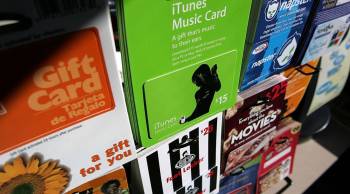Holiday shoppers’ final play is in the cards
Share Now on:
Holiday shoppers’ final play is in the cards
BOB MOON:The big post-holiday sale ads started hitting doorsteps and e-mail inboxes at the crack of dawn today: 25 percent off . . . 50 percent off . . . 75 percent off! As we reported yesterday, many retailers were disappointed by pre-Christmas sales. So today, stores are pinning their bets on all those gift cards that add to their bottom lines as soon as we start spending them. It’s a phenomenon that’s gone from a $4 billion-a-year business a decade ago to more than $70 billion this year.
Dan Horne teaches business at Providence College. And he’s studied the gift card market closely. Dan, welcome to the program.
DAN HORNE: Oh, my pleasure.
MOON: Why is the gift card really becoming so popular, after so many years of wondering whether many of us would feel embarrasesd about giving somebody an impersonal gift card?
HORNE: Well, I think there’s a couple things driving this market. One is the baby boomers are, if nothing else, very practical. And the gift card is really a practical solution to a lot of problems. People have these needs, they get into lots of different gifting relationships, they’re geographically dispersed or they just don’t spend as much time with each other because of time pressures. They don’t really know what people want.
MOON: I can’t escape, though, the feeling that this is really impersonal. I mean, I know it’s an easy out, but isn’t it still an impersonal kind of gift?
HORNE: Well, you know, in an intimate relationship I would say yeah, you’re probably so close to cash. I mean, I’m not going to open up my wallet, hand $20 to a significant other and say “Go buy yourself something nice.” That just wouldn’t convey what a gift is supposed to convey, which is information about the relationship.
But what I can do is I move it a little way away from that and I say here’s an opportunity for you to go shopping at maybe a store that you really like. The other thing, Bob, that’s driving this I think is that . . . the fact that women now are asking for gift cards. And I don’t know if this is the, you know, I call it the “broken dishes strategy” that maybe some guys have, where they, you know, they’re asked to do the dishes and they go in, and they screw it up, they break a dish, and they’re not asked to do it again. Guys have kinda given such bad gifts for so long that maybe women have just said “That’s enough, I’ll do it myself and I’ll get something I really want.”
MOON: Is there any downside to retailers with these things?
HORNE: Well, I don’t think there’s too much downside to the retailers. Retailers have the advantage in that the gift recipient may be somebody who’s never come into the store before, so they have an opportunity for customer acquisition. There’s lift on the spend, which basically means if I come in with a hundred dollar gift card I’m gonna spend, on average, 140 percent of that. You know it’s the found money principle: I’m playing on the house’s money, I’m a lot more free with it.
MOON: Yeah, but I wonder how much of this is a fad factor going on. Do they lose their luster? Is this just a trendy kind of thing in some ways?
HORNE: If someone’s got 15 cards over Christmas, you know it is gonna lose some of its appeal. But what I’ve seen is as long as consumption is hot, you’re gonna see gift cards continue to stay right up there at the top of the list of desired presents for the year.
MOON: Professor Horne, thank you for joining us.
HORNE: Oh, my pleasure. Happy holidays.
There’s a lot happening in the world. Through it all, Marketplace is here for you.
You rely on Marketplace to break down the world’s events and tell you how it affects you in a fact-based, approachable way. We rely on your financial support to keep making that possible.
Your donation today powers the independent journalism that you rely on. For just $5/month, you can help sustain Marketplace so we can keep reporting on the things that matter to you.

















